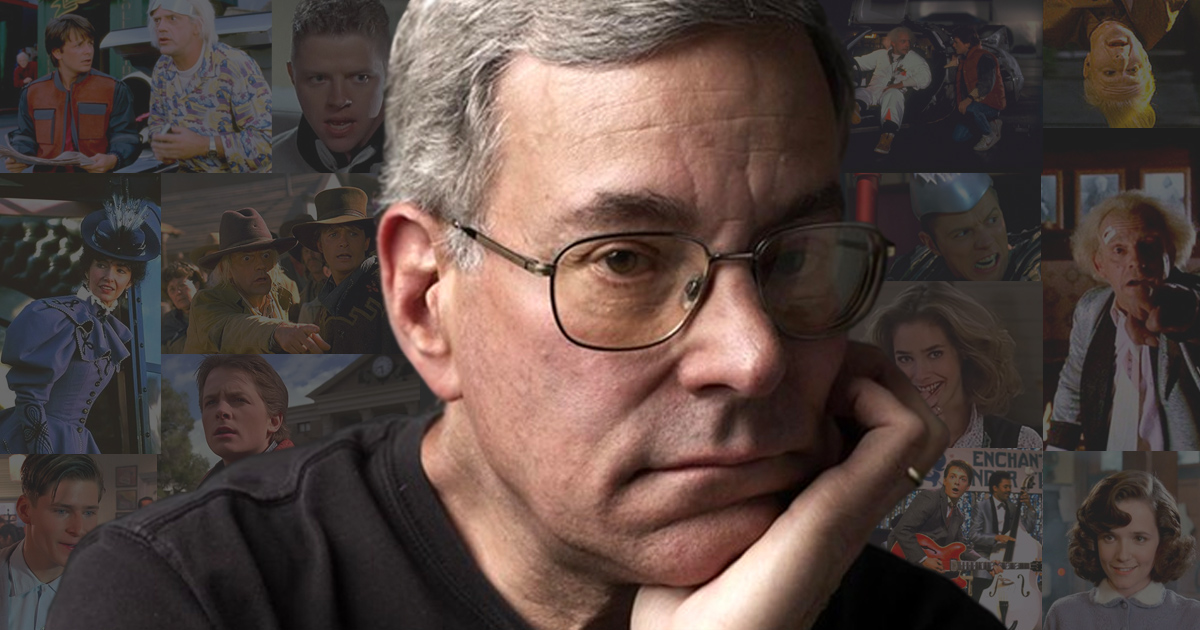
Bob Gale is an Oscar-nominated screenwriter, producer and director, best known as co-creator, co-writer and co-producer of Back to the Future and its sequels. In addition to his work in film, Gale is also an accomplished writer, haven written the novelization to 1941, the novel Retribution High —a short violent novel about bullying & revenge, and a number of comic books including Spider-Man, Batman, Daredevil, Ant-Man and Back to the Future.
His newest book, Back to the Future: DeLorean Time Machine: Doc Brown’s Owner’s Workshop Manual, goes under the hood of one of film’s most iconic cars. From the DeLorean’s unmistakable gull-wing doors to Doc’s cutting-edge modifications, including the Flux Capacitor and Mr. Fusion, the manual offers unprecedented insight into the car’s inner workings, as well as Doc’s journey in getting it built.
We spoke with Gale about the new book, as well as time travel, his writing process and one of the worst Nintendo games ever made.
First of all, congratulations on the book. I thought it was fantastic.
Thank you very much. I appreciate that.
As a longtime fan of the franchise, I think this is exactly what people are going to be looking for.
Well, that was the idea. We wanted it to appeal to whether you were a tech-head or a reasonably serious fan. The Doc Brown journals just kind of arch it over the top, I think.

Now, if there’s anyone that knows as much about the DeLorean Time Machine as Doc Brown, it’s Joe Walser, who you co-wrote the book with. Can you talk about your collaboration with him?
Well, sure. For those who don’t know, Joe was the guy who led the Time Machine restoration project, where we restored the A car DeLorean that appeared in all three movies. It had been left to deteriorate on the backlot of Universal. When I saw what bad shape it was in, I went to the studio and said, “Guys, this is this is important.” And I knew Joe and his partner, Terry Matalas, because they did their own time machine conversion of a DeLorean, and it was one of the best-looking ones I’d ever seen. I knew that Joe was totally passionate about this, so I put him and Terry in charge of the restoration project.
Chris Prince at the publisher, Insight Editions, called me up and said, “Hey, Bob, what do you think about doing this book?” They’d done a book on the vehicles of Ghostbusters and the vehicles in the Marvel Universe, and Chris being a big Back to the Future fan, said, “I want to do the DeLorean.” I said, “Sounds a good idea to me.” He sent me those other books, and I said, “Hey, let’s do Doc Brown’s journals, and we’ve got to get Joe on this. He’s the guy that knows more about it than anybody.” Joe created all those great computer-generated illustrations in the book. He just knocked it out of the park.
One of the things that Joe and I did together at the beginning was come up with names for all the different parts and try to come up with a logic for what they did. This was inspired by the late great Ron Cobb, who was instrumental in creating the whole look of the DeLorean way back in the day. Ron’s approach was, “Everything that’s on here has to have a reason to be here.” Ron was the one that said, “If you’re going to have a nuclear reactor, you have a vent, the way that we know that nuclear facilities have vents So, the big two vents on the back of cars, everybody who doesn’t know that already, it’s explained very clearly in the book that those are actually not exhaust pipes for the engine. They are exhaust pipes for the nuclear reactor. So, Joe and I went through everything that is on the car. Those hockey puck-shaped things that are on the back driver’s side of the car are no longer called ‘hockey puck-shaped things.’ They’re particle accelerator canisters.
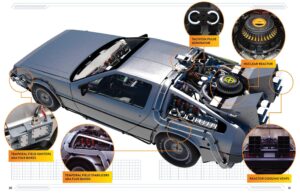
There was some information that was redacted, which is funny because it just meant that you didn’t have to figure out how time travel actually works.
(Laughing) Exactly.
But there’s still a lot of really technical information in the book. Was there a lot of research required for you and Joe?
Sure. We did want to make sure that the ideas about nuclear physics were reasonably accurate, and the different theories about how one would travel through time, such as tachyons and that sort of thing. There are things you have to think about, whether it’s real or just real enough within its universe. For example, the DeLorean travels from Hill Valley in 1985 to Hill Valley in 1955. What accounts for the rotation of the Earth and the movement of the galaxy? Technically, if it was locked into a point in space, that point would be out in the middle of space. So, we wanted to deal with that and just say, “Okay, yeah, that’s a good question.” It’s something certainly that I thought about back when we were working on the movie, and it’s just one of those kinds of things that we just accepted. But let’s explain that. Let’s come up with a theory as to why you would still be in Hill Valley after 30 years.
Well, there are some fans that haven’t accepted it. There are some other issues you brought up, like the limitation of the space on the time display circuit, so you can’t go too far back in time, and why there are flame trails in the sky. There are a lot of little things that people have been bringing up for years. Did you address those just to appease the fans?
Yes, and also to address some things that you realize if you really start thinking about and you put your head to it. We started that when we did the IDW comic books. One of the interesting things that nobody has ever asked in all the years of leading up to the comic books, is that even though Marty goes to Doc’s lab all the time, which we established in the first scene in the movie with the giant speaker when the DeLorean rolls out of the back of Doc’s truck, it’s’ the first time Marty’s ever seen it. So where was it?
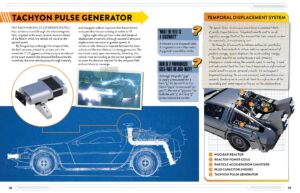
So, you came up with the second lab, which was a brilliant way to explain that.
Right. But again, it’s just one of those things that you just take it on faith. Another one of those things that we don’t really address is if you look at how the DeLorean rolls out of the back of the truck, the clearance between the DeLorean and the edge of the truck is inches. How did that get in there? How did those doors get open? How exactly did that happen?
The book comes off the heels of what is probably the biggest merchandising push for the franchise in its history for the 35th anniversary last year. Why was now the right time for this book?
Well, as far as I’m concerned, anytime is the right time for more Back to the Future stuff.
That’s the correct answer.
You know, when you have an anniversary, that’s a hook that people can hang things. The other thing that’s happened, and this started with the 25th anniversary and really accelerated with Back to the Future Day in 2015, is that kids who saw the movie in the 80s, or even in the 90s, when they watched VHS tapes, are the ones that are in charge of these merchandise companies now. So, they’re thinking, “Hey, Back to the Future was a movie that made a huge impression when I was a kid. Let’s, let’s make some Back to the Future stuff.” They get to call those shots. That’s a whole different dynamic than the dynamic that we had back in 1989 when they made arguably one of the worst eight-bit Nintendo cartridges ever made.
I’m not going to disagree with that.
(Laughing) Don’t. It’s terrible. I actually publicly went out and told people, “Do not buy this piece of garbage.” Somebody actually made a music video that was kind of a tribute to the eight-bit Nintendo cartridge. I don’t know if you saw it or not. The band’s name is Rex Viper. I laughed my head off. It was hilarious. So anyway, that’s the difference. We had people there back in’ 89 that just wanted to make a buck. But the people that are doing this stuff now love the franchise. They love the movies. They want to do it right. So, we have these board games that came out in the last year or two and they’re beautiful. They really thought about what they were doing. That’s kind of a hallmark of all the Back to the Future merchandise that has been coming out in the past 10 or 15 years, that it’s really being done by people who love the movies, and they care, and they say, “Wait a minute, we want to get this right.”
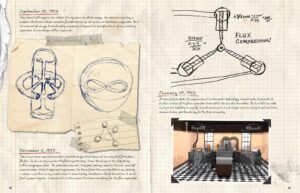
You worked with John Barber from IDW on Doc’s back story in the book, some of which was previously featured in the comics. How much of his backstory did you and John have in your back pockets and how much did you write specifically for the book?
There were certain things that go back before IDW. For example, Bob Zemeckis and I always imagined that Doc Brown had worked on the Manhattan Project. He was the right age for that. If you were a physicist, that was the gold standard to be working on that. Plus, Doc has all of this nuclear physics knowledge. So that’s a perfect fit. Now, it’s not really alluded to at all in the movies. But when you write a character, you always kind of come up with a sort of a fictional biography and you lay that out with the actor so if there’s some reason to draw on that, it’s in there. There are things like how did Marty and Doc meet? We explore that also in the first issue of IDW comics, but Bob and I always imagined that their meeting was pretty much the way it was described. If you live in a town and everybody tells you, “The guy that lives in that house is a nutcase and he’s invented a death ray and he’s dangerous,” the first thing any red-blooded American kid is going to say is, “I’m going over to that guy’s house. I gotta check that sucker out.”
You’ve written for many different types of mediums; screenplays, novels, comics. What’s your writing process like and does it vary from medium to medium?
Sure, it has to vary from medium to medium because the objective of each medium is a little bit different. If you’re writing for network television, the objective is to get people to not switch the channel when the commercials come on. That’s a crass way of saying it. You do want to tell a good story, but you also are aware that it’s part of the equation. If you’re writing a comic book that’s going to run for five or six issues, you want to write the comic book in such a way that when you get to the end of the story, you’re going to want to buy the next issue. With a movie, you have a little bit more space, because you assume that if somebody has bought a ticket to your movie, they’re not going to walk out in 15 minutes. They’re going to stick around, and hopefully, they’ll stay for the whole thing. I always like to have people hooked by the first 30 minutes to make sure that they understand something really interesting is going on and you don’t want to leave the theater now.
Now, that of course, is not the operating principle anymore, because we can so easily channel surf, from Netflix to Amazon Prime to Disney+; whatever services that we have. You just kind of say, “Okay, even though I’ve already paid for this, mentally, it’s free.” It’s not like I got in my car, went all the way to the theater, paid to park, bought a ticket, paid for popcorn. You’re not going to walk out. But if you’re sitting at home, and your dog starts barking and your kid starts screaming. Now you turn off the TV and maybe watch it later.
In the behind scenes section of the book portion of the book, you briefly break down the various screen used Deloreans. In the World of Cinemagic that used to be Universal Studios had what appeared to be the C car as part of the show. Do you know if that was the actual C-car if it was a replica or something else?
I think it may have been the C car. Now the C car is owned by Bill and Patrick Shea in Massachusetts.
They have everything.
You know, whenever they get something, I just feel relief, because I know that those guys love this stuff so much. When they got Doc Brown’s Packard, I said, “Oh, great. Who better to have Doc Brown’s Packard than the Sheas?”
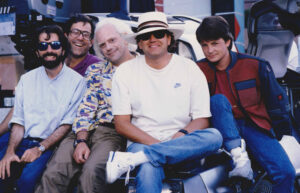
I’m going to get a little nitpicky, so I apologize. In the book, you kind of move away from the alternate timeline theory and move towards time as a flowing river of time, with minor and major diversions, which is something that was brought up in the comics as well. Was it intentional to move away from the alternate timeline theory?
Well, it doesn’t change that view. If you drop a pebble in a stream, the stream keeps going the same way. But if you drop a boulder in it, which is Biff stealing the sports almanac, then you have a whole new tributary. And then the idea is, how do we get that boulder out of this time stream?
Joe Walser is obviously an expert on the DeLorean, but in your research for the book, was there anything new that you both discovered about the car?
I don’t know that we discovered anything new about the car, really. I had to do a little research on some things that were not on the top of my memory banks, like the Julian calendar and the Gregorian calendar. We had an insert about that. I knew that happened, and I roughly knew when it was, but we had to make that was clear and hit that nail right on the head. We did have to do some research on the tires, whether the whitewall tires on the car in Part III were original brand tires or the Sears versions of the tires. But yeah, there were some things where we just had to say, “Oh, we better we better check that out.” Joe has the VIN number in there somewhere.
I just have one last question for you, and this is a personal question that I was hoping for your opinion. I don’t have any tattoos. If I were to get one, it would be of Doc’s sketch of flux capacitor with my children’s initials in the equation. I’ve been told by a tattoo artist that it would just look like a crappy tattoo because it’s a drawing. I just wanted your thoughts on that.
Well, listen, I have seen people with tattoos that include the flux capacitor. People’s arms are just covered with Doc and Marty and the flux capacitor. Whether you do this thing with the equations on it, that’s one I have not seen. But I think you’ll definitely be the only one to have your kids’ initials.
Well, I would hope so.
(Laughing) Then somebody will take a picture of that and say, “Oh, this is a real equation.” Then you’ll be part of Back to the Future folklore.
We would like to extend a special thanks to Bob Gale for taking the time to speak to us. Back to the Future: DeLorean Time Machine: Doc Brown’s Owner’s Workshop Manual is currently available on Amazon or at the Back to the Future store.

